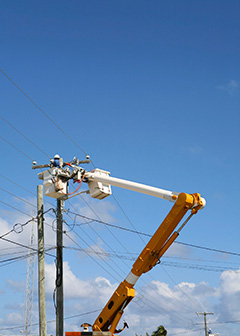How to Become a Line Installer or Repairer About this section

Most installers and repairers have a high school diploma and receive long-term on-the-job training.
To become proficient, most line installers and repairers require long-term on-the-job training and some technical instruction. Formal apprenticeships are common.
Education and Training
Most companies require line installers and repairers to have a high school diploma or equivalent. Employers look for people with basic knowledge of algebra and trigonometry and good reading skills. Technical knowledge of electricity or electronics obtained through military service, vocational programs, or community colleges is helpful.
Many community colleges offer programs in telecommunications, electronics, or electricity. Some programs work with local companies to offer 1-year certificates that emphasize hands-on field work. More advanced 2-year associate’s degree programs provide students with a broad knowledge of the technology used in telecommunications and electrical utilities. These programs offer courses in electricity, electronics, fiber optics, and microwave transmission.
Line installers and repairers get most of their training on the job. Electrical line installers and repairers often must complete formal apprenticeships or other employer training programs. These programs, which can last up to 5 years, combine on-the-job training with technical instruction and are sometimes administered jointly by the employer and the union representing the workers. Safety regulations define the training and educational requirements for apprentice electrical line installers, but licensure is not required.
Line installers and repairers working for telephone and cable television companies receive several years of on-the-job training. They also may attend training or get technical instruction from equipment manufacturers, schools, unions, or industry training organizations.
Certification
Although it is not mandatory, certification for line installers and repairers is available from several associations. For example, the National Joint Apprenticeship and Training Committee offers certification for line installers and repairers in several specialty areas.
The Fiber Optic Association also offers certification programs specifically in fiber optics: the FOA Certification presents three levels of fiber optic certification for telecommunications line installers and repairers.
Advancement
Entry-level line workers generally begin with classroom training and an apprenticeship. Their on-the-job training begins with basic tasks, such as ground work and tree trimming. As they learn additional skills from more experienced workers, they may advance to stringing cable and doing service installations. In time, they advance to more sophisticated maintenance and repair positions in which they are responsible for increasingly large portions of the network.
After 3 to 5 years of working, qualified line workers reach the journey level. A journey-level line worker is no longer considered an apprentice and can do most tasks without supervision. Journey-level line workers may also qualify for positions at other companies. Workers with many years of experience may become first-line supervisors or may become trainers.
Important Qualities
Color vision. Workers who handle electrical wires and cables must be able to distinguish colors because the wires and cables are often color coded.
Mechanical skills. Line installers and repairers must have the knowledge and skills to repair or replace complex electrical and telecommunications lines and equipment.
Physical strength. Line installers and repairers must be strong enough to lift heavy tools, cables, and equipment on a regular basis.
Stamina. Line installers and repairers often must climb poles and work at great heights with heavy tools and equipment. Therefore, these workers must be able to be physically active for long periods without tiring.
Teamwork. Because workers often rely on their fellow crew members for their safety, teamwork is critical.
Technical skills. Line installers use sophisticated diagnostic equipment on circuit breakers, switches, and transformers. They must be familiar with electrical systems and the appropriate tools needed to fix and maintain them.
Troubleshooting skills. Line installers and repairers must be able to diagnose problems in increasingly complex electrical systems and telecommunication lines.
Workers who drive company vehicles usually need a commercial driver's license.








